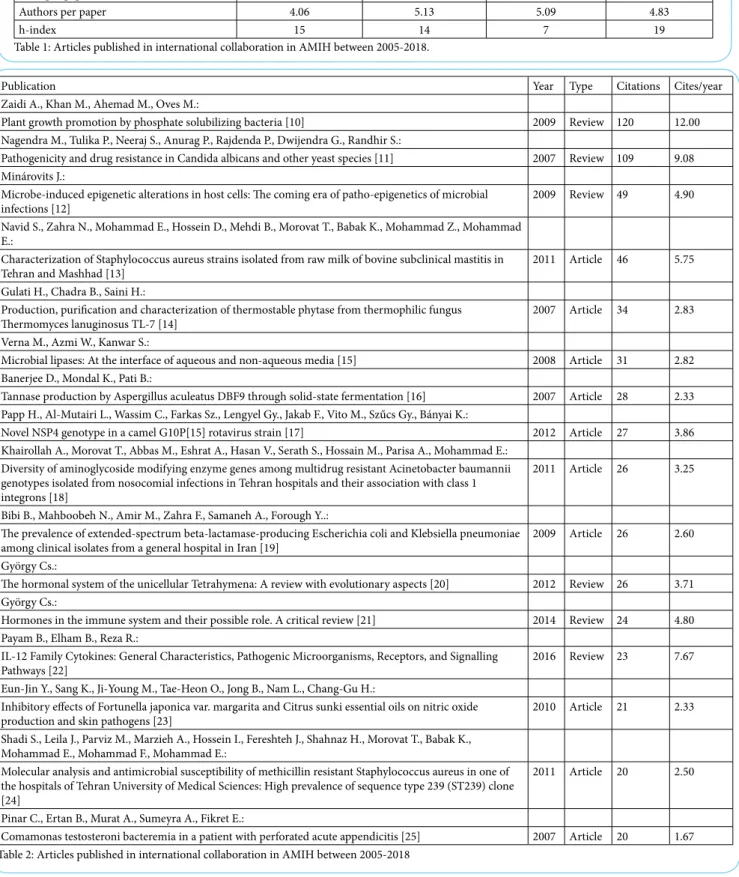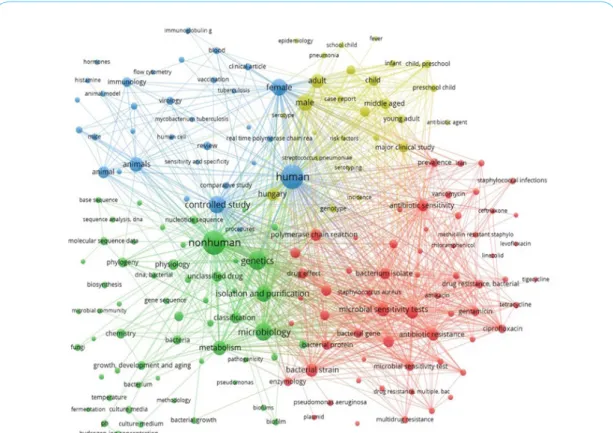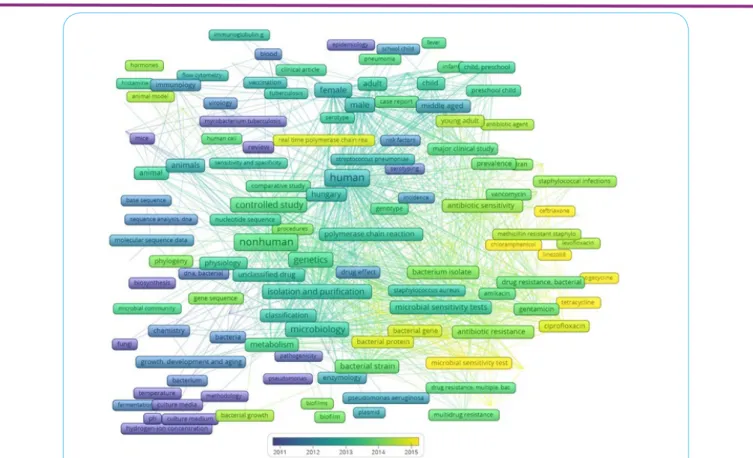A Bibliometric Profile of Acta Microbiologica et Immunologica Hungarica: 2005-2018
Original Article Open Access
*Corresponding Author: Prof. Márió Gajdács, Department of Pharmacodynamics and Biopharmacy, Faculty of Pharmacy, University of Szeged, 6720 Szeged, Eötvös utca 6., Hungary; E-mail: mariopharma92@gmail.com
Citation: Gajdács M (2019) A Bibliometric Profile of Acta Microbiologica et Immunologica Hungarica: 2005-2018. Int J Clin Med Microbiol 4: 139. doi: https://
doi.org/10.15344/2456-4028/2019/139
Copyright: © 2019 Gajdács. This is an open-access article distributed under the terms of the Creative Commons Attribution License, which permits unrestricted use, distribution, and reproduction in any medium, provided the original author and source are credited.
Clinical & Medical Microbiology
Márió Gajdács
Department of Pharmacodynamics and Biopharmacy, Faculty of Pharmacy, University of Szeged, 6720 Szeged, Eötvös utca 6., Hungary
VOSviewer 1.6.9 software was used to generate the collaboration and word co-occurrence networks from the recovered data [9].
Results and Discussion
The total number of documents published in AMIH during the study period (2005-2018) was 464 (Table 1.) The most frequently published document type indexed by Scopus was „original article”
(n=420, 90.52%), followed by „review” (n=32, 6.89%; first occurrence in 2005), „letter” (n=5, 1.08%; first occurrence in 2010) and „short survey” (n=2, 0.43%; first occurrence in 2005). Additionally, there were two papers classified as an „editorial” (in 2009 and 2010) and three as an „erratum” (2008-2010), respectively. The average amount of authors per paper remained relatively consistent throughout the years (4.06-5.13; Table 1).
Regarding the impact of papers in AMIH, articles published between 2005 and 2018 were cited 2384 times overall, averaging 5.14 citations per each paper (Table 1.). The average ratio of self-citations was 9,97±6,61% (1.72-18.28%; lowest in 2013, highest in 2015). The papers with high amount of citations (defined as 20 or more cites, n=16) correspond to 26.43% of total citations (52.50 citations per year, 206.57 cites/author) for AMIH (articles listed in Table 2.). The journal received its first IF in 2010 (Table 3.) and it reached its highest value for the 2016/17 citation period (1.107).
Publication History:
Received: February 12, 2019 Accepted: March 16, 2019 Published: Macrh 18, 2019
Keywords:
Acta Microbiologica et Immunologica Hungarica, bibliometric analysis, microbiology, immunology, citation, cluster analysis
Introduction
Acta Microbiologica et Immunologica Hungarica (AMIH) is a quarterly publication, which was founded by the Hungarian Academy of Sciences (MTA). The journal is devoted to publishing manuscripts in all fields of medical microbiology, immunology and studies regarding the human microbiome, looking for submissions from both Hungarian study groups and an international audience of scientists [1]. Additionally, supplement issues related to the conferences organized by the Hungarian Society of Microbiology (MMT) are also published. Bibliometrics is a tool for quantification which uses scientific communication between scholars as the basis for analysis [2]. It is concerned with the qualitative and quantitative assessment of research, that is often used for the evaluation of various journals, research institutions, universities, study groups or individual scientists [3,4]. The bibliometric analysis of a journal may be important for several reasons. The authors mainly study commonly known bibliometric parameters (such as impact factor (IF), Hirsch-index (h-index), number of publications per year etc.) before the potential submission of manuscripts. In addition, university libraries also often evaluate the abovementioned characteristics before including journals in their collection [5,6]. Another important landmark for any journal is the inclusion to major databases and indexing services (such as PubMed/MEDLINE, Web of Science, Scopus), which will help to increase the reputation of a journal, allowing for a wider audience.
The present study aims to give a bibliometric overview of AMIH in a 14-year period (2005-2018), since the journal was listed by major international content indexing services.
Materials and Methods
The bibliometric data analyzed in this study, dating between 2005 and 2018 was extracted from the Scopus database on the 5th of January 2019. The information was exported in RIS (Research Information Systems, Incorporated) file format to the Harzing’s Publish or Perish 6.44 software for data analysis [7,8]. In addition,
Abstract
Acta Microbiologica et Immunologica Hungarica (AMIH) is a quarterly publication, which was founded by the Hungarian Academy of Sciences (MTA), devoted to publishing manuscripts in all fields of medical microbiology, immunology and studies regarding the human microbiome. Bibliometrics is an area of science, which is concerned with the qualitative and quantitative assessment of research, that is often used to evaluate the impact of journals, institutions, study groups or individual scientists. The aim of this study is present a general overview of AMIH from 2005 to 2018 using bibliometric indicators. The data analyzed in this study, dating between 2005 and 2018 was extracted from the Scopus database. The information was exported in RIS file format to the Harzing’s Publish or Perish 6.44 software for data analysis. In addition, VOSviewer 1.6.9 software was used to generate the collaboration and word co-occurrence networks.
The total number of documents published in AMIH during the study period (2005-2018) was 464, and these articles were cited 2384 times overall, averaging 5.14 citations per each paper. The average ratio of collaborative papers was 18.13%. The average ratio of self-citations for AMIH was around 10%, which could be considered a good result compared to some international publications. Acta Microbiologica et Immunologica Hungarica manages to reach a wide audience of the Hungarian scientific community of researchers interested in its content. The submission of additional articles from a wider audience would strengthen the international reach and scientific impact of AMIH.
Table 2: Articles published in international collaboration in AMIH between 2005-2018
Publication years 2005-2009 2010-2014 2014-2018 Overall
Number of papers 127 (27.37%) 183 (39.44%) 154 (33.19%) 464
Citations 1123 (47.11%) 994 (41.69%) 267 (11.20%) 2384
Cites per year 80.21 110.44 66.75 170.29
Cites per paper 8.84 5.43 1.73 5.14
Authors per paper 4.06 5.13 5.09 4.83
h-index 15 14 7 19
Table 1: Articles published in international collaboration in AMIH between 2005-2018.
Publication Year Type Citations Cites/year
Zaidi A., Khan M., Ahemad M., Oves M.:
Plant growth promotion by phosphate solubilizing bacteria [10] 2009 Review 120 12.00
Nagendra M., Tulika P., Neeraj S., Anurag P., Rajdenda P., Dwijendra G., Randhir S.:
Pathogenicity and drug resistance in Candida albicans and other yeast species [11] 2007 Review 109 9.08
Minárovits J.:
Microbe-induced epigenetic alterations in host cells: The coming era of patho-epigenetics of microbial
infections [12] 2009 Review 49 4.90
Navid S., Zahra N., Mohammad E., Hossein D., Mehdi B., Morovat T., Babak K., Mohammad Z., Mohammad E.:
Characterization of Staphylococcus aureus strains isolated from raw milk of bovine subclinical mastitis in
Tehran and Mashhad [13] 2011 Article 46 5.75
Gulati H., Chadra B., Saini H.:
Production, purification and characterization of thermostable phytase from thermophilic fungus
Thermomyces lanuginosus TL-7 [14] 2007 Article 34 2.83
Verna M., Azmi W., Kanwar S.:
Microbial lipases: At the interface of aqueous and non-aqueous media [15] 2008 Article 31 2.82
Banerjee D., Mondal K., Pati B.:
Tannase production by Aspergillus aculeatus DBF9 through solid-state fermentation [16] 2007 Article 28 2.33
Papp H., Al-Mutairi L., Wassim C., Farkas Sz., Lengyel Gy., Jakab F., Vito M., Szűcs Gy., Bányai K.:
Novel NSP4 genotype in a camel G10P[15] rotavirus strain [17] 2012 Article 27 3.86
Khairollah A., Morovat T., Abbas M., Eshrat A., Hasan V., Serath S., Hossain M., Parisa A., Mohammad E.:
Diversity of aminoglycoside modifying enzyme genes among multidrug resistant Acinetobacter baumannii genotypes isolated from nosocomial infections in Tehran hospitals and their association with class 1 integrons [18]
2011 Article 26 3.25
Bibi B., Mahboobeh N., Amir M., Zahra F., Samaneh A., Forough Y..:
The prevalence of extended-spectrum beta-lactamase-producing Escherichia coli and Klebsiella pneumoniae
among clinical isolates from a general hospital in Iran [19] 2009 Article 26 2.60
György Cs.:
The hormonal system of the unicellular Tetrahymena: A review with evolutionary aspects [20] 2012 Review 26 3.71
György Cs.:
Hormones in the immune system and their possible role. A critical review [21] 2014 Review 24 4.80
Payam B., Elham B., Reza R.:
IL-12 Family Cytokines: General Characteristics, Pathogenic Microorganisms, Receptors, and Signalling
Pathways [22] 2016 Review 23 7.67
Eun-Jin Y., Sang K., Ji-Young M., Tae-Heon O., Jong B., Nam L., Chang-Gu H.:
Inhibitory effects of Fortunella japonica var. margarita and Citrus sunki essential oils on nitric oxide
production and skin pathogens [23] 2010 Article 21 2.33
Shadi S., Leila J., Parviz M., Marzieh A., Hossein I., Fereshteh J., Shahnaz H., Morovat T., Babak K., Mohammad E., Mohammad F., Mohammad E.:
Molecular analysis and antimicrobial susceptibility of methicillin resistant Staphylococcus aureus in one of the hospitals of Tehran University of Medical Sciences: High prevalence of sequence type 239 (ST239) clone [24]
2011 Article 20 2.50
Pinar C., Ertan B., Murat A., Sumeyra A., Fikret E.:
Comamonas testosteroni bacteremia in a patient with perforated acute appendicitis [25] 2007 Article 20 1.67
The journal is indexed in two subject categories, namely Medicine (miscellaneous) and Immunology and microbiology (miscellaneous);
the journal has been categorized in the Q2-Q3 rank in the former and Q3-Q4 in the latter category, based on the international impact of the papers published in AMIH (Table 4.). The ratio of collaborative publications (defined as articles with authors from more than one country) in AMIH was also assessed as this is another relevant factor by which the reach of journals may be assessed. Presented in Table 5., the average ratio of collaborative papers was 18.13%.
In order to establish the network of collaborators and the profile of the journal in more depth, the authors and the keywords present in the titles and abstracts of the published documents were analyzed
2010 2011 2012 2013 2014 2015 2016 2017
IF 0.625 0.787 0.646 0.780 0.778 0.568 0.921 1.107
Table 5: Articles published in international collaboration in AMIH between 2005-2018.
Category 2005 2006 2007 2008 2009 2010 2011
Medicine
(miscellaneous) Q2 Q2 Q3 Q3 Q3 Q3 Q3
Immunology and microbiology (miscellaneous)
Q4 Q4 Q4 Q4 Q4 Q4 Q4
2012 2013 2014 2015 2016 2017 2018 Medicine
(miscellaneous) Q3 Q3 Q3 Q3 Q3 Q3 Q3
Immunology and microbiology (miscellaneous)
Q4 Q3 Q4 Q4 Q4 Q3 Q4
2005 2006 2007 2008 2009 2010 2011
% 20.83% 18.18% 9.68% 24.14% 16.67% 19.35% 5.26%
2012 2013 2014 2015 2016 2017 2018
15.91% 27.03% 18.92% 18.42% 13.51% 25.64% 20.33%
Table 3: Impact factor of AMIH 2005-2018. Table 4: Articles published in international collaboration in AMIH
between 2005-2018.
Figure 1: Co-author collaboration network from documents published in AMIH between 2005-2018.
Figure 2: Overlay visualization of co-author collaboration based on year of publication in AMIH between 2005-2018.
Figure 3: Keyword co-occurrence network from documents published in AMIH between 2005-2018.
content, being the main national publication for submissions related to the scope (medical microbiology, immunology, microbiome- studies etc.) of this journal. Additionally, an evolution of the research topics covered by the published papers could be observed, based on the cluster analysis performed. As an added value, AMIH possesses a considerable impact factor, which may further encourage researchers to submit their work in this journal, as there is increasing pressure to publish in international journals with (preferably high) impact factors, because this has become a pre-requisite for the awarding of doctoral (PhD) degrees, in addition to the successful application for research grants. The submission of additional articles from a wider audience would strengthen the international reach and scientific impact of AMIH.
Funding
M.G. was supported by the National Youth Excellence Scholarship [Grant Number NTP-NTFÖ-18-C-0225] and the ESCMID Mentorship and Observership Programme.
Competing Interests
The author declare no competing interests.
References
1. https://akademiai.com/loi/030
2. Jain S, Basavaraj P, Singla A, Singh K, Kundu H, et al. (2015) Bibliometric analysis of journal of clinical and diagnostic research (dentistry section;
2007-2014). J Clin Diagn Res 9: 47-51.
by VOSviewer to generate clusters and co-occurrence networks.
Together with the connecting lines, the colors in Figures 1 and 3 indicate the relationship of the authors and keywords, while in Figures 2 and 4, the shade of color indicates the temporal nature of relationships. Out of 1639 authors, 272 met the threshold to become
“nodes” in the generated network, while 149 could be included in the network (i.e., had at least one co-authored paper with another author qualifying to be a “node”) to generate clusters of association (Figure 1 and Figure 2). In addition, 6090 keywords were identified by VOSviewer, from which 1497 met the threshold to become “nodes”
and 178 was enrolled in the generation of the co-occurrence network (Figure 3 and Figure 4). The keywords “article” and “English article”
were excluded for methodological reasons. Based on these results, the topics covered by published articles reflected on the changing trends in microbiological sciences in the respective study period [26].
Conclusions
This study presents a qualitative and quantitative bibliometric analysis of the leading trends that occurred in Acta Microbiologica et Immunologica Hungarica between 2005 and 2018, using the Scopus database for the collection of bibliographic information and specialized software for data analysis. The average ratio of self-citations for AMIH was around 10%, which could be considered a good result compared to some international publications, and especially if compared to other journals based in Hungary. To assess AMIH from a different perspective, our research also presents keyword co-occurrence and collaboration networks of the journal. Acta Microbiologica et Immunologica Hungarica manages to reach a wide audience of the Hungarian scientific community of researchers interested in its
Figure 4: Overlay visualization of keyword co-occurrence based on year of publication in AMIH between 2005-2018.
26. Gajdács M (2018) Open Research: Past, Present, and Future. In: The Global Benefits of Open Research (The 2018 MDPI Writing Prize). 1st Edition, Chapter: 12, pp. 33-35.
3. Corrales IE, Reyes JJ, Fornaris Y (2016) Bibliometric analysis of the Journal of Oral Research (2012-2015). J Oral Res 5: 188-193.
4. Baladi ZH, Umedani LV (2017) Pakistan Journal of Medical Sciences: A bibliometric assessment 2001-2010. Pak J Med Sci 33: 714-719.
5. Restrepo G, Willett P (2017) The Journal of Mathematical Chemistry: a bibliometric profile. J Math Chem 55: 1589-1596.
6. Gajdács M (2019) A bibliometric analysis of Acta Pharmaceutica Hungarica (1965-2018). Acta Pharm Hung,
7. Krauskopf K (2018) A bibiliometric analysis of the Journal of Infection and Public Health: 2008-2016. J Infect Pub Health 11: 224-229.
8. https://harzing.com/resources/publish-or-perish
9. Gutiérrez-Salcedo M, Ángeles Martínez M, Moral-Munoz JA, Herrera- Viedma E, Cobo MJ (2018) Some bibliometric procedures for analyzing and evaluating research fields. Appl Int 48, 1275-1287.
10. Zaidi A, Khan MS, Ahemad M, Oves M (2009) Plant growth promotion by phosphate solubilizing bacteria. Acta Microbiol Immunol Hung 56: 263-284.
11. Mishra NN, Prasad T, Sharma N, Payasi A, Prasad R, et al. (2007) Pathogenicity and drug resistance in Candida albicans and other yeast species. Acta Microbiol Immunol Hung 54, 201-235.
12. Minárovits J (2009) Microbe-induced epigenetic alterations in host cells:
The coming era of patho-epigenetics of microbial infections. Acta Microbiol Immunol Hung 56: 1-19.
13. Sahebekhtiari N, Nochi Z, Eslampour MA, Dabiri H, Bolfion M, et al. (2011) Characterization of Staphylococcus aureus strains isolated from raw milk of bovine subclinical mastitis in Tehran and Mashhad. Acta Microbiol Immunol Hung 58: 113-121.
14. Gulati H, Chadra B, Saini H (2007) Production, purification and characterization of thermostable phytase from thermophilic fungus Thermomyces lanuginosus TL-7. Acta Microbiol Immunol Hung 54: 121- 138.
15. Verna M, Azmi W, Kanwar S (2008) Microbial lipases: At the interface of aqueous and non-aqueous media. Acta Microbiol Immunol Hung 55: 265- 294.
16. Banerjee D, Mondal K, Pati B (2007) Tannase production by Aspergillus aculeatus DBF9 through solid-state fermentation. Acta Microbiol Immunol Hung 54: 159-166.
17. Papp H, Al-Mutairi LZ, Chehadeh W, Farkas SL, Lengyel G, et al. (2012) Novel NSP4 genotype in a camel G10P[15] rotavirus strain. Acta Microbiol Immunol Hung 59: 411-421.
18. Asadollahi K, Taherikalani M, Maleki A, Alizadeh E, Valadbaigi H, et al. (2011) Diversity of aminoglycoside modifying enzyme genes among multidrug resistant Acinetobacter baumannii genotypes isolated from nosocomial infections in Tehran hospitals and their association with class 1 integrons.
Acta Microbiol Immunol Hung 58: 359-370.
19. Bazzaz BS, Naderinasab M, Mohamadpoor AH, Farshadzadeh Z, Ahmadi S, et al. (2009) The prevalence of extended-spectrum beta-lactamase-producing Escherichia coli and Klebsiella pneumoniae among clinical isolates from a general hospital in Iran. Acta Microbiol Immunol Hung 56: 88-89.
20. Casaba G ((2012)) The hormonal system of the unicellular Tetrahymena: A review with evolutionary aspects. Acta Microbiol Immunol Hung 59: 131- 156.
21. Csaba G (2014) Hormones in the immune system and their possible role. A critical review. Acta Microbiol Immunol Hung 61: 241-260.
22. Behzadi P, Behzadi E, Ranjbar R (2016) IL-12 Family Cytokines: General Characteristics, Pathogenic Microorganisms, Receptors, and Signalling Pathways. Acta Microbiol Immunol Hung 63: 1-25.
23. Eun-Jin Y, Sang K, Ji-Young M, Tae-Heon O, Jong B, Nam L, et al. (2010) Inhibitory effects of Fortunella japonica var. margarita and Citrus sunki essential oils on nitric oxide production and skin pathogens. Acta Microbiol Immunol Hung 57: 15-27.
24. Shahsavan S, Jabalameli L, Maleknejad P, Aligholi M, Imaneini H, et al.
(2011) Molecular analysis and antimicrobial susceptibility of methicillin resistant Staphylococcus aureus in one of the hospitals of Tehran University of Medical Sciences: High prevalence of sequence type 239 (ST239) clone.
Acta Microbiol Immunol Hung 58: 31-39.
25. Pinar C, Ertan B, Murat A, Sumeyra A, Fikret E (2007) Comamonas testosteroni bacteremia in a patient with perforated acute appendicitis.
Acta Microbiol Immunol Hung 54: 317-321.



